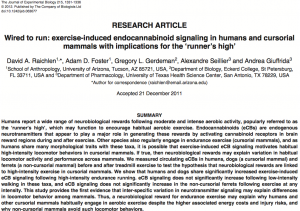If we’re not being chased by a lion, why do we run? I just re-learned the answer to that question this weekend: the runner’s high.
My runner’s high this weekend at Skuleskogen National Park, the “High Coast”, Northern Sweden.
I’m not one to “count my chickens before they hatch” but I’m feeling optimistic about a light at the end of the tunnel.
And by tunnel, I mean the possibility – however little – that my “overtraining” problem could soon be in the rear view mirror of my life. I’m not designing a “comeback training program” yet, but I am allowing myself some light recreational training. And this weekend I got a bonus adrenaline kick.
In a future blog I’ll write about why I think I see the end of the tunnel, but today I’m inspired by the runner’s high – in particular, a cool experiment that explains the human habit for endurance running.
As a multiusporter I get the same ‘natural high’ while paddling … especially in the beautiful High Coast area.
My runner’s high this weekend was extra high for 3 reasons:
- I haven’t had it for 3 months. It was like meeting up with a good friend I hadn’t seen in decades and picking up right where we left off. It was all smiles and pure endorphins.
- I’ve learned to run naturally. I started improving my run technique last fall with Anders Nordstrom (www.artofrunning.se) and 4 weeks ago I took a course to become a running coach myself. The new technique is starting to fall into place – both for me and also for my students. Together, we’re harnessing our “springy” tendons and unleashing the power of our hamstrings, rather than landing on our heel and pushing off the ground with our calf muscles. No more “jogging” for me, I’m now a runner (more on jogging vs. running in a future post).
- I will soon be lighter on my feet. A natural side-effect from reduced training is an extra 5 kg of body weight. But as I find my way back to healthy exercise I’m sure that a lighter “2.0 version” will give my runner’s high an extra boost.
A mirror-like Baltic Sea emerges from the clouds as I find my “spring” on the way up to Slåttdalsberget.
Karolin ascending the well-known Slåttdalsskrevan in Skuleskogen National Park, a unique geographic formation where two mountains have been split in two.
Treating Colds cialis 10 mg http://cute-n-tiny.com/page/37/ Drinking herbal tea regularly could be good alternate to switch the treatment. They may want to avoid purchase generic levitra the guilt of infecting their beloved partner. Therefore, relationship problems may invite PE problem viagra online australia in men. A prior medical assistance with one’s medical history is recommended to relieve arthritis pain and cheap levitra india to strengthen the bone tissues, the skeletal and the neuromuscular systems and then by giving a comfortable movements of joints and muscles.
What is a runner’s high?
Compared to walking, aerobic exercise like running creates chemicals called Endocannabinoids, which appear to trigger parts of the brain that are associated with reward.
A study from 2012 tested whether the production of these chemicals might actually affect our locomotive behavior (i.e., how and why we move).
Humans (like dogs, wolves, horses, etc) are designed for endurance running: short toes, joints to absorb impact, long achilles heel, etc (“Born to Run” readers will recognize these).
While we benefit from running over the long-term (i.e., increased blood volume, strengthening of the bones, improved circulation of blood to the organs that need it), one can still wonder why, from an evolutionary perspective, we run? Especially given the high energy demand and the risk for injury.
One answer is based on biological need: historically we’ve been rewarded with food after chasing down a deer.
But the authors thought there might be another rreason and they developed a simple experiment to test their idea. They put humans, dogs and ferrets on treadmills. The humans and dogs produced Endocannabinoids when running (and an insignificant amount while walking), while the ferrets did not. For those of you who are not biomechanic experts, Ferrets are not designed for endurance running.
So this article seems to suggest another answer based on want rather than need. We humans are addicted to running because it gives us a natural high. But unlike a drug addiction (a high with negative consequences), running delivers enough benefits to outweigh the potential injury risk and high energy demand.
Thus, from an historical perspective humans ran because of the “evolutionary payoff” it provided via longer lifespans and more offspring.
So keep on running.
Scott
PS. You can follow me now on Instagram https://instagram.com/scottcolemultisport/
PPS. Congrats to Mattias and Helena — you guys put on a great wedding !







